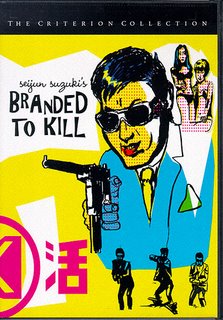
Branded to Kill
(Japan, 1967, 98 min.)
Starring Jo Shishido, Mariko Ogawa, Annu Mari, Koji Nambara, Isao Kamagawa, Hiroshi Minami.
Written by Hachiro Guryu, Takeo Kimura, Chusei Sone and Atsushi Yamatoya.
Directed by Seijun Suzuki.
Shishido plays Hanada, a.k.a. No. 3 Killer, an aloof, puffy-cheeked assassin employed in a bizarre murderous hierarchy, which seems to be based as much on self-destruction as murder for hire (its members spend far more of the film’s running time shooting at one another than they do other people). After a string of jobs, he meets a mysterious young woman, Misako (Mari), who engages him for another killing. When this goes wrong, owing to a twist of fate straight out of the butterfly effect (literally; what is it with these butterflies and their incessant need to affect world events far beyond their narrow lepidopteric scope?), Misako is kidnapped, and Hanada is marked for death by his own organization, eventually finding himself in a strange psychological contest with elusive No. 1 Killer, The Phantom (Nambara).
The first time I watched this film, I just couldn’t wrap my mind around it. The second time, well, to say that I understood it better would be a bit of an overstatement; let’s leave it at I didn’t find it as difficult to follow. And that’s probably good enough, as I’ve become increasingly sure that Branded to Kill functions under the Eraserhead factor: the sooner you realize you’re not necessarily supposed to “get” it, the sooner you can sit back, relax, and enjoy the film’s oddball nature unfettered.
The story doesn’t exactly develop so much as, as the enigmatic No. 1 says at one point, “Things happen.” The bebop that pops up on the soundtrack seems appropriate as, along with the loopy camera angles and static rhythms, Suzuki often appears to be improvising the narrative as he goes along. (And perhaps he was. He was fired from Nikkatsu Studios after completion of this film for straying too far from what they had expected.) Or maybe this is the Japanese cinematic equivalent of beat poetry, if we really want to strain those comparative muscles.
At times it comes off as a parody of gangster films, particularly when Hanada and The Phantom begin their dance of endurance, leading up to a truly odd and somewhat disturbing scene in a restaurant. The scenes with Ogawa as Hanada’s coquettishly slutty, frequently naked wife Mami also have a delirious humor cum creepiness to them, while other bits veer surprisingly close to out and out slapstick.
Hanada is a man with an increasing lack of control over the circumstances of his life. Assaults fly at him from all directions in both the actions of his fellow murderers and from nature itself. If compelled at the point of a gun to assign some meaning to all of this, I’d say that it’s a portrait of a man coming to the realization that no matter how big the blaster, nor an individual’s willingness to use it, there is no guarantee of power or control, there will always be forces that can overwhelm. But I’m personally more interested in a room full of dried butterflies, Hanada attempting to have a conversation with a film screen, a hairpiece swirling around in a toilet bowl, and the eroticism of the scent of boiling rice.
Sometimes it’s more fun just to sit back and watch things happen.
Go back to Plate O' Shrimp


<< Home